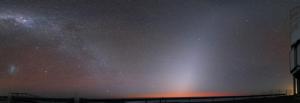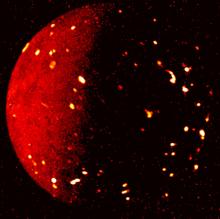A glowing pyramid known as zodiacal light extends upward from the horizon in this view from the European Southern Observatory in Chile. Zodiacal light is formed as sunlight reflects off grains of dust scattered in the plane of the solar system. Recent research suggests the grains may come from Mars. At this time of year, zodiacal light is best seen before dawn on a dark, moonless night. The band of the Milky Way arcs across the left side of the image. [ESO]
You are here
Zodiacal Light
From a light-polluted city or suburb, the night sky features the Moon, the bright planets, and a few dozen to a few hundred stars. If you escape city lights, though, you’ll see that parts of the night sky glow. There’s the faint band of the Milky Way, which arcs high across the sky on September evenings. And before dawn now, there’s a glowing pyramid called zodiacal light — sunlight reflecting off countless particles of dust.
The name comes from the light’s location — along the zodiac. The particles of dust are there all the time. But they’re easiest to see before dawn around the start of autumn, and after sunset at the start of spring. The zodiac stands at a good angle then, and the Sun is just below the horizon, so it lights up the dust.
The dust grains may come from asteroids and comets. But recent research says that most of them may come from Mars.
During its cruise from Earth to Jupiter, the Juno spacecraft was hit by many grains of dust. They knocked off bits of the craft’s giant solar arrays, which provide electricity. The bits of debris from the arrays showed up as streaks of light in pictures of the space around Juno. Extensive analysis showed that most of the impacts took place from Earth to just beyond Mars — an indication that the dust came from Mars. A comparison to computer models showed a good match to the band of dust that makes up the zodiacal light — clouds that will glow in the east before dawn until the Moon overpowers them later this month.
Script by Damond Benningfield
Get Premium Audio
Listen to today's episode of StarDate on the web the same day it airs in high-quality streaming audio without any extra ads or announcements. Choose a $8 one-month pass, or listen every day for a year for just $30.






